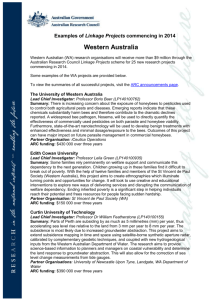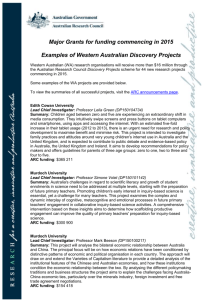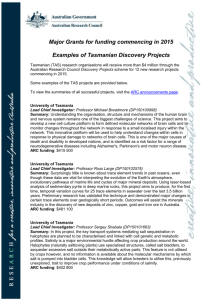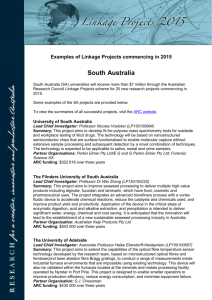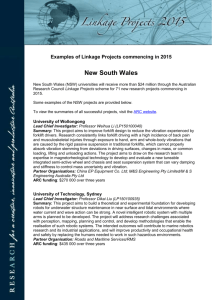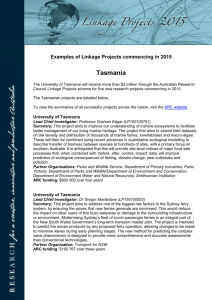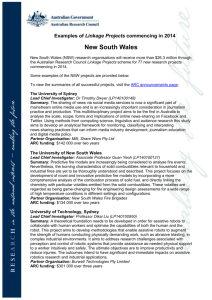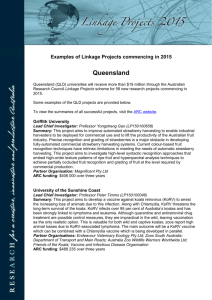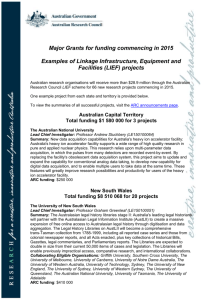Word Format - Australian Research Council
advertisement
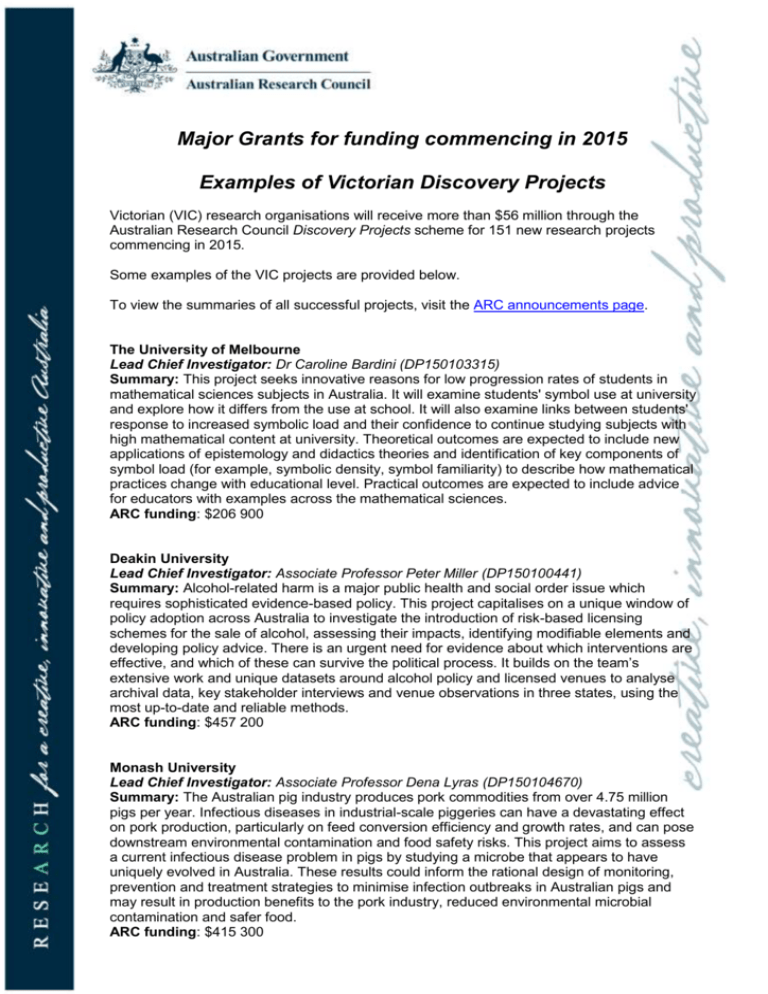
Major Grants for funding commencing in 2015 Examples of Victorian Discovery Projects Victorian (VIC) research organisations will receive more than $56 million through the Australian Research Council Discovery Projects scheme for 151 new research projects commencing in 2015. Some examples of the VIC projects are provided below. To view the summaries of all successful projects, visit the ARC announcements page. The University of Melbourne Lead Chief Investigator: Dr Caroline Bardini (DP150103315) Summary: This project seeks innovative reasons for low progression rates of students in mathematical sciences subjects in Australia. It will examine students' symbol use at university and explore how it differs from the use at school. It will also examine links between students' response to increased symbolic load and their confidence to continue studying subjects with high mathematical content at university. Theoretical outcomes are expected to include new applications of epistemology and didactics theories and identification of key components of symbol load (for example, symbolic density, symbol familiarity) to describe how mathematical practices change with educational level. Practical outcomes are expected to include advice for educators with examples across the mathematical sciences. ARC funding: $206 900 Deakin University Lead Chief Investigator: Associate Professor Peter Miller (DP150100441) Summary: Alcohol-related harm is a major public health and social order issue which requires sophisticated evidence-based policy. This project capitalises on a unique window of policy adoption across Australia to investigate the introduction of risk-based licensing schemes for the sale of alcohol, assessing their impacts, identifying modifiable elements and developing policy advice. There is an urgent need for evidence about which interventions are effective, and which of these can survive the political process. It builds on the team’s extensive work and unique datasets around alcohol policy and licensed venues to analyse archival data, key stakeholder interviews and venue observations in three states, using the most up-to-date and reliable methods. ARC funding: $457 200 Monash University Lead Chief Investigator: Associate Professor Dena Lyras (DP150104670) Summary: The Australian pig industry produces pork commodities from over 4.75 million pigs per year. Infectious diseases in industrial-scale piggeries can have a devastating effect on pork production, particularly on feed conversion efficiency and growth rates, and can pose downstream environmental contamination and food safety risks. This project aims to assess a current infectious disease problem in pigs by studying a microbe that appears to have uniquely evolved in Australia. These results could inform the rational design of monitoring, prevention and treatment strategies to minimise infection outbreaks in Australian pigs and may result in production benefits to the pork industry, reduced environmental microbial contamination and safer food. ARC funding: $415 300 RMIT University Lead Chief Investigator: Professor Qian Ma (DP150104719) Summary: This project represents a potential milestone in the development of three-dimensional printing of titanium alloys by selective laser melting. The purpose of this project is to develop essential fundamental knowledge and novel processing routes for three-dimensional printing of titanium alloys to ensure the achievement of better than forged mechanical properties for critical applications. The outcomes of the project are expected to enable access to new markets and supply chains, improve Australia's competitively advantage and national research strength in this critical sector of manufacturing, and enhance the long-term viability of Australia's resources and manufacturing industries. ARC funding: $310 700 La Trobe University Lead Chief Investigator: Dr Nicola Stern (DP150100487) Summary: The southern tip of the Mungo lunette is an icon of Australia's Indigenous past. Despite its international significance, the archaeological traces have disintegrated as the lunette has eroded over the past 30 years. In this interdisciplinary project, collaboration with Elders from the Willandra Lakes Region World Heritage Area is expected to reconstruct the history of environmental changes and the life-ways of the first humans to settle this region. The focus will be on stitching together the archaeological traces scattered through space and time, and on measuring processes of modern sediment erosion and deposition so as to develop management strategies for the future protection of this unique archive of Australia's past. ARC funding: $472 343 Swinburne University of Technology Lead Chief Investigator: Dr Baohua Jia (DP150102972) Summary: High performance and environmentally friendly on-chip power system is the key bottleneck issue limiting the further performance improvement and miniaturisation of ever-increasing portable optoelectronic devices. Building on previous work, including recent breakthroughs of on-chip photonic devices in patterned graphene oxide thin film and the record-breaking nanophotonics solar cells, the project aims to investigate a new concept of super-resolution direct laser printing and simultaneous dopant activation of graphene oxide thin films. It is expected that the conceptually new development of the functional graphene oxide film patterning will allow for smart solar-powered on-chip power systems that outperform the state-of-the-art pollution generating batteries. ARC funding: $375 100 The University of Melbourne Lead Chief Investigator: Professor Janet McCalman (DP150100682) Summary: What really happened to the Diggers after the war? In this centenary year of Gallipoli, it is still not known. It is not known how long they lived nor how they compared in health and family formation to civilians. Did some recover from trauma and exposures over time? Did the Repatriation Scheme and medical care make a difference? What social and biological characteristics may have affected risk, resilience and recovery? And what can be learnt about the lifelong impact of war exposures and traumas, to assist in the recovery of today's servicemen? This project aims to be the world's first cradle-to-grave medico-demographic study of survivors of military service in World War I, drawing on Australia's unique archive of service and veteran medical records. ARC funding: $560 000 Monash University Lead Chief Investigator: Professor Jean Armstrong (DP150100003) Summary: Accurate information about the position of a person or device is essential in many situations. However, despite extensive worldwide research, there is still no positioning system suitable for many important indoor applications. The widespread introduction of energy efficient white light emitting diodes (LEDs) for indoor lighting provides an unprecedented opportunity to solve this problem by using these LEDs to transmit signals from which a receiver can calculate its position. However the theory underlying the design and analysis of position estimation using modulated optical signals does not exist. This project aims to develop this fundamental theoretical basis and apply it to create the accurate indoor positioning systems of the future. ARC funding: $384 700 RMIT University Lead Chief Investigator: Professor David Moss (DP150104327) Summary: Bandwidth and energy demands of telecommunications networks are rapidly reaching a crisis point technologically, economically and from a sustainability viewpoint. At the same time, on-chip interconnects for silicon integrated circuits are also reaching a bottleneck. This project aims to combine the expertise of eight leading international groups to pioneer nonlinear photonic integrated circuits compatible with silicon technology (Complementary Metal Oxide Semiconductor technology, or CMOS) to achieve new capabilities on a chip for signal generation, processing and measurement for telecommunications, computers, and fundamental science. These platforms are expected to allow the integration of electronics with photonics and to be faster, cheaper, smaller, and more energy efficient than current technology. ARC funding: $743 900 The University of Melbourne Lead Chief Investigator: Associate Professor Kenneth Crozier (DP150103736) Summary: Recent years have seen staggering growth in the prevalence of digital cameras. Conventional digital cameras are designed to mimic the response of the human eye, and therefore record the intensities of three spectral channels: red, green and blue (RGB). This project aims to harness recent advances in nano-optics for the realisation of a new generation of digital cameras. Rather than performing simple colour (RGB) imaging, these will be capable of multispectral and polarisation-resolved imaging, whose richer information will be beneficial for applications from medical diagnostics to industrial quality control. These capabilities will be enabled by optical nanostructures that deflect light in a wavelength- and polarisation-dependent manner. ARC funding: $544 100 The University of Melbourne Lead Chief Investigator: Professor Caron Beaton-Wells (DP150100504) Summary: The major supermarket chains have a substantial economic and social impact on consumers, businesses and communities and are crucial to Australia's economic growth and productivity. Given their size and reach, regulation of the chains poses significant challenges. This interdisciplinary, empirical and theoretically driven project aims to interrogate the goals and processes of competition law as it applies in the retail grocery sector. In the first Australian research of its kind, it endeavours to explain how the chains' strategies and industry relationships influence regulatory action. The research is expected to produce recommendations on instruments and techniques to ensure that regulation of the sector is legally and practically efficient and effective. ARC funding: $372 900
